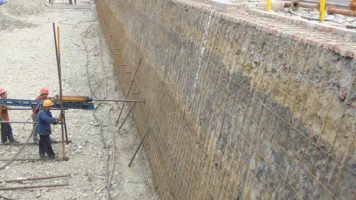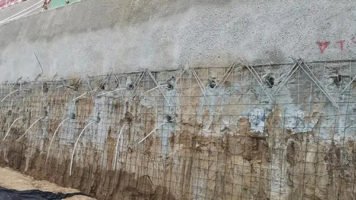Soil nail wall support is to make soil nails, surface layer, and soil into a composite retaining structure through soil nailing reinforcement technology. Today, Sinorock will introduce this technology applied to the foundation slope to you.
- What is the construction process of the SOIL NAIL WALL?
- What can be used as SOIL NAILS?
- Where can SOIL NAIL WALLS be used?
Construction Process of Soil Nail Wall
The soil nailing wall construction process is as below.
- Layered excavation
- Slope correction
- Measure and layout lines
- Determine the position of the soil nails
- Adjust the angle
- Drive the soil nails, reinforce
- Tie the steel mesh and soil nails for anchoring
- Spray the surface layer of concrete
- Curing concrete
Working Mechanism of Soil Nail Wall
The working mechanism of the soil nailing wall is that high-strength soil nails, concrete surface, and original soil are jointly stressed, thereby increasing the strength and bearing capacity of the soil. There are four types of applications of the soil nailing wall.
1. Effect of Composite Soil
Soil nails and soil mass work together to form a composite soil mass with a higher strength to bear the soil pressure behind the wall. Soil nails can generate the anchoring effect effectively to restrain the deformation of the soil.
Soil nails are made of steel, therefore, it has higher tensile and flexural strength. When the soil is deformed into plastic after the shaping stage, the stress is gradually borne by the soil nails, which reduces the stress concentration and increases the bearing capacity of the soil. Within the structure, the external load is mainly supported by soil nails. The soil nails play a role in stress transfer and equalization in the composite. Soil nails are densely arranged on the slope, which is equivalent to adding a skeleton to the soil mass. Therefore, it plays the role of reinforcement and improves the strength of the soil.
2. Similar to Gravity Retaining Wall
Due to the large number of soil nails and the smaller spacing, a composite soil mass is formed between them, and its structure is similar to a gravity retaining wall. The soil nail wall can bear the lateral pressure of the soil and the external load at the top, restricting the slope deformation, to ensure the stability of the excavation slope.
3. Slope Protection
The main function of the surface layer of the soil nailing wall is to maintain the stability of the soil and connect the soil nails and soil as a whole. Soil nails combined with concrete, can effectively limit the lateral deformation of the slope soil, and strengthen the edge of slope constraints. The surface layer of the soil nail wall also prevents damage to the soil by equipment and personnel. Also, it plays an important role in preventing rain from infiltrating into the slope and affecting the stability of the slope.
4. Soil Arch effect
Constrained by soil nails, the further the soil is away from the soil nails, the larger the deformation. Therefore, soil arches are formed between the soil nails to maintain the stability of the soil between the nails.
What Can Be Used as Soil Nails?
Steel pipes, angle steels and other shaped steels, steel bars, bamboo, and logs, all of these can be used as soil nails. However, the most effective soil nail is the self-drilling soil nail. It can combine drilling, grouting, and anchoring in one process. It is safe, efficient, and convenient and is suitable for broken rock, loose soil, and geological conditions where is difficult to drill holes.
Applications of Soil Nail Wall
Soil nail wall support is mainly suitable for sandy soil, cohesive soil, silt, loess, and miscellaneous fill soil.
There are three main aspects of soil nailing wall support:
- Temporary support during soil excavation: such as foundation pit excavation, underground structure excavation, etc.;
- Permanent retaining structure: such as slope retaining wall, tunnel opening retaining wall, etc.;
- Repair, reconstruction, emergency rescue, and reinforcement of existing retaining structures and supporting structures.
Advantages of Soil Nail Wall
- The site required for construction is small, and the movement is flexible. The supporting structure basically does not occupy space alone and can be excavated close to the existing buildings. This is difficult to achieve with supports such as piles and walls. When large-scale slope protection construction equipment does not have enough working face, it shows unique advantages;
- Fast construction speed: The soil nail wall is constructed with the earthwork excavation, which is carried out in layers and sections, which can basically be synchronized with the earthwork excavation, and does not require maintenance or occupies the construction period alone. Therefore, in most cases, the construction speed is faster than other supporting structures;
- The construction equipment and process are simple, complex technology and large-scale machinery and tools are not required, and the construction has little interference with the surrounding environment;
- Due to the small aperture, compared with construction methods such as piles, the ability to penetrate pebbles, boulders, and rock fill is stronger; the construction is convenient and flexible, and the construction will not be affected when the excavation surface is irregular in shape and the slope is inclined;
- The number of materials and the amount of engineering is less, and the engineering cost is lower. According to the data analysis, the cost of a soil nailing wall project is generally 1/3 to 1/5 lower than other types of retaining structures.
Conclusion
Soil nail wall has the advantages of simple construction, short construction period, low cost, safety, and reliability in deep foundation pit support. It has good application and development prospects in ground engineering and deep foundation engineering.






